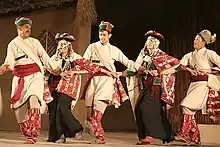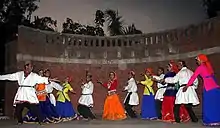The word Nati is used for the traditional folk songs sung in the Western and Central Hills of the Indian subcontinent. It is primarily native to the states of Himachal Pradesh and Uttarakhand. Nati is traditionally performed in the Kullu, Shimla, Sirmaur, Kinnaur, Dehradun, Tehri Garhwal, Uttarkashi. However, due to high immigration of ethnic paharis in the plains, this has been made popular in the plains too. Nowadays many consider pahari dance as nati but it actually corresponds to pahari songs. Traditionally, locals dance to the beats of percussion instruments called Dhol-Damau. Pahari dance is listed in the Guinness Book of World Records as largest folk dance.

Varieties
There are several varieties of Nati performed like Kullvi Nati, Mahasuvi Nati, Sirmauri Nati, Kinnauri Nati, Brada Nati, Bangani Nati, Jaunpuri Nati, Saraji Nati, Suketi Nati, Churahi Nati, etc. People of Lahaul district have their own distinct dance called "Garphi" and Nati is not a part of Lahauli culture.[1] The Kinnauri Nati dance is mime-like and includes languid sequences. Important among the dances of Nati is 'Losar shone chuksom'. The name from Losai, or the New Year. Activities such as sowing the crop and reaping it are included in it.

Records
The Nati Dance in the second week of January 2016 was listed in the Guinness Book of World Records as the largest folk dance in the world. Nati entered in the book as the largest folk dance in terms of participants’ number. Total 9892 women participated in this folk dance in their traditional colourful Kullvi dress on 26 October 2015 during International Dussehra festival. [2]
References
- ↑ "Himachal Pradesh Dances - Folk Dances of Himachal Pradesh, Traditional Dance Himachal Pradesh India". Bharatonline.com. Retrieved 2 January 2017.
- ↑ "kullu nati get guinees world record certificate". The Times of India. Retrieved 3 February 2016.